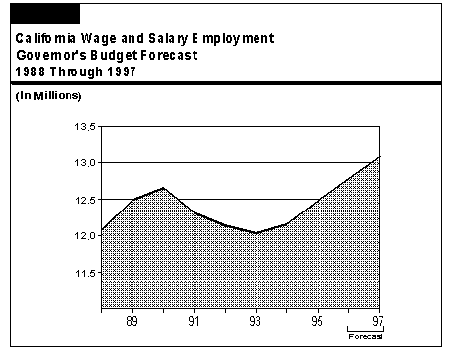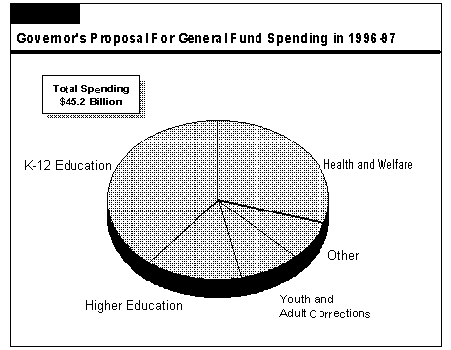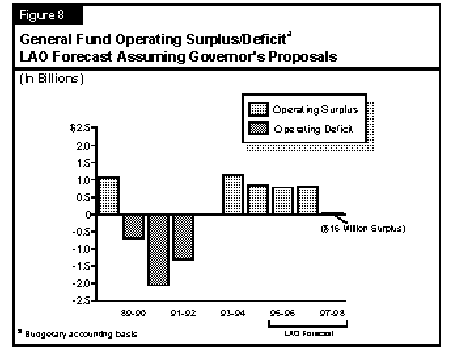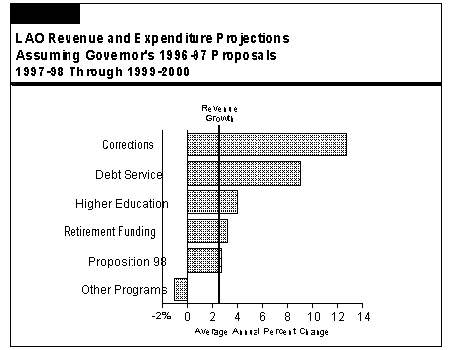

The Governor and Legislature will, however, face a variety of challenges and uncertainties in formulating the state's 1996-97 spending plan. For example, many of the assumed savings in this year's enacted state budget, as well as a number of savings proposals in the Governor's 1996-97 budget proposal, require federal actions which at this time are tied up with the budget impasse in Washington. Likewise, policymakers will also face key decisions regarding whether to make permanent a number of temporary budget reductions enacted in past years which are scheduled to be restored in 1996-97. These include the suspension of the renters' credit, welfare cost-of-living adjustments (COLAs), and certain welfare grant reductions. The restoration of these programs would increase spending requirements by $1.7 billion in 1996-97. Given the current outlook for revenues and expenditures, it does not appear that there will be sufficient resources in the budget year to accommodate all spending requirements of current law, including these restorations.
Figure 1 briefly outlines the main features of the Governor's budget proposal. In general, the new budget has many similarities to the initial 1995-96 spending proposal. It includes a major tax reduction, additional welfare restrictions and grant reductions, full funding for the state's corrections budget, funding for K-14 education at the Proposition 98 minimum guarantee level, and significant increases for higher education. The proposal also would make permanent the elimination of the renters' credit and the past temporary welfare reductions, for a savings of $1.7 billion from current-law spending requirements in 1996-97.
| Figure 1 Main Features of the Governor's Budget Proposal | |||
|---|---|---|---|
| Cuts income taxes by 15 percent. | |||
| Makes permanent previously-enacted renters' credit suspension and welfare savings. | ||
| Targets health and welfare programs for additional reductions. | ||
| Fully funds corrections budget. | ||
| Funds K-14 education at the Proposition 98 minimum guarantee level. | ||
| Increases spending significantly for higher education. | ||
| Relies on federal actions to achieve $2.6 billion of savings. | ||
The Department of Finance's (DOF's) economic forecast assumes that both the U.S. and California economies will expand at a moderate rate with low inflation over the next two years. As indicated in Figure 2, the budget projects that California will have recouped the 725,000 jobs lost in the recent recession by mid-1996, and that the state will have 13 million jobs by the end of next year. Economic growth in the state will be led by international trade, high technology industries, tourism, and entertainment-related activities. The administration forecasts that homebuilding will experience a modest rebound, due to continued projected job growth and low interest rates.

The well-publicized slowdown in the national economy has been more abrupt than anticipated by the administration when it prepared its current economic projections in late 1995. Thus, the consensus of forecasts for the nation is now more conservative than the Governor's budget projection. However, the national slowing does not appear to be carrying over into California at this time. In fact, the most recent reports for California indicate that economic growth in this state is currently stronger than anticipated in the budget forecast. A more complete review of recent national and state economic developments, along with the administration's and our own economic projections, is included in Part II of this volume.
The budget forecasts General Fund revenues of $45 billion in the current year (an increase of almost $1 billion over the 1995 Budget Act estimate) and $45.6 billion in the budget year. This represents revenue growth of 5.3 percent in 1995-96 and 1.3 percent in 1996-97. The low revenue growth rate in the budget year is partly due to the Governor's tax reduction proposal (which would lower revenues by $572 million in the budget year), and his trial court funding proposal (which would reduce trial court revenues--and expenditures--by $311 million in 1996-97). Expiration of the temporary 10 percent and 11 percent marginal income tax brackets after 1995 also will lower revenue growth during the year. After adjusting for these and other changes affecting revenue collections, the underlying revenue increase is somewhat higher--about 4.7 percent.
This underlying 4.7 percent revenue growth rate, however, is still somewhat low in relation to the budget's projected gains in the economy. This reflects the DOF's assumption that key revenue-related variables will expand more slowly than the general economy over the next year. As indicated in Part III of this volume, we believe that revenues will grow more in line with the economy over the next year, and as a result, that General Fund revenues could exceed the budget projections by nearly $1 billion in the current and budget years combined.
The majority of state budget decisions focus on spending from the General Fund, which supports most of the state's major education, health, social services, and criminal justice programs. In 1996-97, the Governor proposes to spend $45.2 billion from the General Fund. In addition, the budget proposes spending of $14.9 billion from special funds for such purposes as transportation, targeted health programs, and local governments.
Figure 3 shows the distribution of General Fund spending proposed in the Governor's Budget. It shows that over 90 percent of the total is related to four major program areas--K-12 education (about 40 percent), health and social services programs (about 30 percent), higher education (13 percent), and adult and youth corrections (9 percent). The remainder is for general government and a variety of business, transportation, housing and tax relief programs.
Figure 4 shows proposed revenues and expenditures for 1995-96 and 1996-97 and the resulting General Fund condition for each year. It indicates that both revenues and expenditures would grow slowly in 1996-97 under the Governor's plan, reflecting the various spending and tax reduction proposals. Revenues would total $45.6 billion, or slightly more than the expenditure total of $45.2 billion. As a result, the General Fund reserve would grow from $50 million in 1995-96 to $404 million in 1996-97.

| Figure 4 Governor's Budget General Fund Condition 1995-96 and 1996-97 (In Millions) | |||||||||||||
|---|---|---|---|---|---|---|---|---|---|---|---|---|---|
| 1995-96 | 1996-97 | Percent Change | |||||||||||
| Prior-year balance | -$342 | $403 | |||||||||||
| Revenues and transfers | 44,991 | 45,571 | 1.3% | ||||||||||
| Total resources available | $44,649 | $45,973 | |||||||||||
| Expenditures | $44,246 | $45,242 | 2.3% | ||||||||||
| Ending fund balance | $403 | $731 | |||||||||||
| Reserve | $50 | $404 | |||||||||||
| Other obligations | $353 | $327 | |||||||||||
| Detail may not add to totals due to rounding. | |||||||||||||
The proposed 1996-97 spending levels reflect about $2.4 billion in savings relative to spending levels that would be required by current law (excluding the effect of the $311 million Trial Court Funding redirection). As indicated in Figure 5, about $1.7 billion of these reductions are from making permanent the temporary welfare grant reductions and the suspension of the renters' credit and welfare COLAs. The remaining $700 million is related to savings in health and welfare programs.
| Figure 5 1996-97 Governor's Budget Major Proposals Net Gain to the General Fund (In Billions)a | ||||
|---|---|---|---|---|
| Make Temporary Savings Permanent | ||||
| Welfare grant reductions and COLA suspension: | ||||
| AFDC | $0.3 | |||
| SSI\SSP | 0.8 | |||
| Renters' credit | 0.5 | |||
| Total | $1.7 | |||
| New Reductions/Savings | ||||
| Welfare: | ||||
| AFDC--additional 4.5 percent grant reduction | $0.1 | |||
| SSI\SSP--eliminate eligibility for most noncitizens | 0.1 | |||
| Welfare block grant savings | 0.4 | |||
| Medi-Cal: | ||||
| Eliminate prenatal services for illegal immigrants and some optional benefits | 0.1 | |||
| Adopt cost-containment and co-payment measures | 0.1 | |||
| Total | $0.7 | |||
| New Initiatives | ||||
| Tax reduction proposal: | ||||
| Rate reductions and various other provisions | -$0.6 | |||
| Offset for reduced growth in Proposition 98 school funding | 0.4 | |||
| New programs/expansions: | ||||
| Expand family planning and teen pregnancy prevention | -0.1 | |||
| Tax checkoff for local public safety | -0.2 | |||
| Buy out UC/CSU fee increases | -0.1 | |||
| Total | -$0.5 | |||
| Net Gain to General Fund | $2.0 | |||
| a Amounts include effects in both 1995-96 and 1996-97. | ||||
| Detail may not add to totals due to rounding. | ||||
Partly offsetting these savings are a $572 million reduction in revenues related to the Governor's proposed income tax cuts. After taking into account the effect of the revenue reduction on Proposition 98's spending requirements (which would decline by about $350 million), the net "cost" to the rest of the General Fund would be slightly over $200 million in 1996-97. The budget also proposes additional spending for teenage pregnancy prevention programs, local public safety, and higher education.
In the following sections, we discuss the Governor's major spending and tax-reduction proposals in more detail.
Most of the budget's major savings proposals affect health and welfare, especially grant levels in the state's two major cash assistance programs. These programs provide payments to low-income persons who are in families with dependent children (AFDC) or who are elderly, blind, or disabled (SSI/SSP).
Make Permanent the Temporary Welfare Grant Reductions and COLA Suspension. The Governor's Budget proposes to make permanent the temporary AFDC and SSI/SSP grant reductions adopted in 1992-93 (5.8 percent) and 1995-96 (4.9 percent statewide). In addition, the 1991-92 suspension of COLAs would be made permanent. Under current law, these grant reductions and the COLA suspension are required to be restored in 1996-97. The Governor's proposal would avoid increased costs of $1.1 billion in the budget year.
Additional AFDC Grant Reduction. The budget proposes an additional 4.5 percent reduction to AFDC grants in 1996-97, for a savings of $111 million. The budget indicates that the maximum monthly grant for a family of three after both the previous reductions and this additional reduction would be $540 in the 17 high-rental-cost counties, and $514 in the other counties.
Bar Immigrants From Receiving SSI/SSP Benefits. The budget assumes enactment of federal legislation barring most legal immigrants from receiving SSI/SSP benefits starting January 1, 1997. The budget assumes savings of $91 million from this proposal. The budget also indicates that the administration intends to include in its mandate relief legislation a ban on counties providing general assistance to legal immigrants excluded from the SSI/SSP program and various other federally funded programs.
Welfare Block Grant Savings. The budget assumes enactment of federal legislation to provide block grant funding of the AFDC and Child Welfare Services (CWS) programs. (Such legislation was vetoed in January by the President, but remains part of the federal budget negotiations.) The budget assumes that the state would receive approximately the same level of federal funds as in 1994-95. However, caseloads have declined slightly and grant levels would be lower than in 1994-95 (after implementation of pending and proposed reductions). As a result, California would receive more federal funds than it would otherwise, resulting in state savings of $366 million.
Proposal for Future Welfare Redesign. The Governor proposes legislation to fundamentally redesign the state's AFDC program, effective in 1997-98. The current AFDC program would be replaced by four new programs for low-income families with children. The proposal has no impact on the 1996-97 budget since it would not be effective until the following year. At this time, the administration has not provided any estimates of the future fiscal effects of this proposal, which is still undergoing development.
Medi-Cal Savings Proposals. The budget continues to assume that the state will receive federal funds to pay for the state's share of costs for emergency health care provided to illegal immigrants. These amounts total $519 million in the current and budget years combined. The budget also proposes to eliminate prenatal services for illegal immigrants effective March 1, 1996, for a savings of $87 million through 1996-97. Additionally, several optional benefits not required by federal law would be eliminated for a net savings of $34 million. Medi-Cal cost control proposals would save about $95 million and include continuation of drug rebates, reduced rates for distinct-part nursing facilities, and co-payment requirements for optional benefits.
Expand Services for Family Planning and Prevention of Teen Pregnancies. The budget proposes $46 million to expand the existing teen pregnancy prevention program, and $20 million to establish a fully state-funded new component of the Medi-Cal program to provide contraceptive services to low-income women.
Proposition 98. In the current year, the budget increases General Fund Proposition 98 spending for K-12 schools and community colleges by about $600 million to meet the state's minimum funding guarantee. Of this amount, $225 million offsets lower property tax revenues and increased enrollment. The remaining $375 million results from stronger state revenue growth and would be used to provide one-time funding to schools for technology, math and English task forces, and other purposes.
For 1996-97, the budget provides a further increase of about $900 million (3.7 percent) in order to meet the state's General Fund Proposition 98 funding requirement, including $150 million for repayment of past Proposition 98 loans under the tentative settlement of the CTA v. Gould lawsuit. The budgeted level of Proposition 98 funding in 1996-97 is $350 million less than it would be in the absence of the Governor's tax reduction proposal. This is because the Proposition 98 funding guarantee decreases by about 60 cents for every dollar reduction in General Fund revenues (given current economic and revenue projections).
Higher Education. The budget implements the second year of the Governor's compact with higher education. General Fund support for the University of California (UC) and the California State University (CSU) would increase by 6 percent and 5.2 percent, respectively. These increases would fund a general 4 percent increase consistent with the compact and provide additional funds to avoid any increase in general student fees.
Renters' Credit. The renters' credit provides an income tax credit to California renters in the amount of $60 for single renters and $120 for married couples or heads of households. The credit is refundable, so that renters may file and receive the full amount even if they have no income tax liability. The credit was suspended from 1993 through 1995. The budget proposes to repeal the renters' credit permanently for an estimated savings of $520 million in 1996-97.
Corrections. The budget includes an increase of about 11 percent (about $350 million) in General Fund support for the Department of Corrections, primarily to accommodate growing inmate populations.
Trial Court Funding. The budget proposes to consolidate and restructure the Trial Court Funding Program. The proposal would redirect from the General Fund to the Trial Court Trust Fund fines and penalties collected by the trial courts. In turn, state expenditures for the trial courts would come from the trust fund rather than the General Fund. This restructuring would reduce General Fund revenues and spending by $311 million apiece in 1996-97. The proposal also includes an increase in filing fees to provide additional court funding to the Trial Court Trust Fund. While this proposal does not result in increased state costs in the budget year, it would result in increased state costs in future years. This is because the counties' contribution would be capped and the state would pay all additional costs.
Tax Checkoff for Citizens' Option for Public Safety. The budget proposes to fund a new program that would augment funding for local public safety. The Citizens' Option for Public Safety program would allow taxpayers to designate 1 percent of their state income tax liability for local public safety programs. The state would provide these funds to local governments as General Fund subventions. The budget estimates that these designations would result in a cost of $150 million in 1996-97.
A major vulnerability of this budget is that many of its savings proposals and assumptions depend on federal action--either legislation or administrative waivers. Federal legislation which would accomplish these savings is currently being considered in Washington, D.C. As Figure 6 shows, a total of $2.6 billion in state savings require federal actions, of which about $2 billion relates to health and welfare programs.
The federal changes are needed to implement 1994-95 and 1995-96 budget savings relating to reimbursements for illegal immigrant costs and to welfare reductions, as well as new welfare savings assumed in the Governor's 1996-97 spending plan.
In general, the federal assumptions contained in the new budget proposal are more realistic than in past years. Most of the necessary federal legislation is currently in one or more versions of the federal budget or welfare reform legislation now under consideration by Congress. Enactment of these measures, however, depends on the President and Congress reaching agreement on versions of the federal budget and welfare reform which contain the specific actions that are assumed in the Governor's proposed budget.
The lack of federal progress on these measures since the introduction of the Governor's Budget in January has already reduced state savings that were anticipated in the current year by about $150 million. Further delays would cause this figure to grow.
The budget includes a variety of tax reduction provisions as part of the Governor's plan to "Invest in California's Competitiveness." The heart of the Governor's tax proposal is a 15 percent across-the-board reduction in personal income tax and bank and corporation tax rates to be phased in evenly over a three-year period beginning January 1, 1997. Tax rates for both individuals and corporations would be reduced by 5 percent in 1997, 10 percent in 1998, and 15 percent in 1999 from their
| Figure 6 1996-97 Governor's Budget Savings That Depend on Federal Actions (In Millions) | |||
|---|---|---|---|
| Budgeted 1995-96 | Savings 1996-97 | Totals | |
| Implement Previous Budget Actions: | |||
| AFDC | |||
| Grant reduction adopted in 1994-95a | $22 | $44 | $66 |
| Grant reductions adopted in 1995-96a | 63 | 58 | 121 |
| Restrict eligibility of sponsored immigrants | -- | 28 | 28 |
| Maximum family granta | -- | 4 | 4 |
| SSI/SSP | |||
| Grant reductions adopted in 1995-96 | 101 | 101 | 202 |
| Eliminate eligibility based on addiction | -- | 6 | 6 |
| Offset delinquent state taxes against federal refunds | -- | 85 | 85 |
| Make Temporary Savings Actions Permanent | |||
| AFDC | |||
| Make 1995-96 statewide grant reduction permanenta | -- | $129 | $129 |
| SSI/SSP | |||
| Make 1995-96 statewide grant reduction permanent | -- | 309 | 309 |
| Federal Welfare Reform Changes | |||
| AFDC | |||
| Child Welfare Services block grant funding | $91 | $275 | $366 |
| Child support payment recovery changes | 1 | -14 | -13 |
| SSI/SSP | |||
| Restrict eligibility of noncitizens | 1 | 84 | 85 |
| Restrict disabled child eligibility | -- | 6 | 6 |
| Funding for Illegal Immigrant Costs | |||
| Medi-Cal emergency care | $216 | $303 | $519 |
| Incarceration of felons | 233b | 324 | 556 |
| New Proposals | |||
| AFDC | |||
| Additional 1996-97 grant reduction (4.5%) | -- | $111 | $111 |
| Medi-Cal | |||
| Nursing facilities rate reductions | -- | 26 | 26 |
| Totals | $728 | $1,879 | $2,606 |
| a May be authorized by either administrative waiver or legislation. | |||
| b Amount budgeted in excess of $45 million already appropriated. | |||
| Detail may not add to totals due to rounding. | |||
1996 levels. As a result, the top rates for both individuals and corporations would be reduced from 9.3 percent in 1996 to 8.84 percent in 1997, 8.37 percent in 1998, and 7.91 percent in 1999.
The budget contains a variety of other tax reduction provisions. Most of these provisions were considered by the Legislature last year, but none were enacted. These include a reduction in the insurance tax rate charged to businesses for annuities, a research and development tax credit increase, an increase in the amount of property that a small business may expense (that is, deduct fully in the initial tax year), and several other provisions with small fiscal effects. The Governor estimates that his proposal would reduce tax revenues by $10.8 billion over the initial four-year phase-in period. The yearly tax reduction amount would go from $572 million in 1996-97 (a partial-year effect) to $4.7 billion by 1999-00 (when the reductions are fully phased in). In Part V of this volume, we discuss the proposed tax cut in more detail, including its effects on individual taxpayers, the state's fiscal condition, and the California economy.
In this section, we provide our perspective on the General Fund outlook for the budget year and beyond based on our projections for the economy, revenues, and expenditures. We have prepared these estimates to assist the Legislature in evaluating the near-term and longer-term effects of the Governor's budget proposals, and to help the Legislature in shaping its own budget priorities.
For purposes of these estimates, we have assumed all of the federal actions needed to implement the Governor's Budget, adjusting only for delays that have already occurred. For example, we assume that welfare reductions tied to federal welfare reform will be enacted in March 1996 versus January 1996 as assumed in the budget.
Our main findings with regard to the budget year are as follows:
| Figure 7 LAO's General Fund Condition With Governor's Proposals 1995-96 Through 1997-98 (In Millions) | ||||||||
|---|---|---|---|---|---|---|---|---|
| 1995-96 | 1996-97 | 1997-98 | ||||||
| Prior-year balance | -$342 | $428 | $1,225 | |||||
| Revenues and transfers | 45,216 | 46,339 | 47,793 | |||||
| Total resources available | $44,874 | $46,767 | $49,018 | |||||
| Expenditures | $44,446 | $45,542 | $47,777 | |||||
| Ending fund balance | $428 | $1,225 | $1,241 | |||||
| Reserve | $75 | $898 | $913 | |||||
| Other obligations | $353 | $327 | $327 | |||||
| Detail may not add to totals due to rounding. | ||||||||
To look at the second-year impact of the Governor's proposals, we have developed revenue and expenditure projections for 1997-98. These projections assume that the California economy continues to grow at a moderate rate. We also include the second-year effect of the 1996-97 budget proposals--including the tax cut, which would lower revenues by $2 billion in 1997-98. As with the current and budget years, our estimates for 1997-98 assume that the state budget savings dependent on federal action are achieved.
Our projections indicate that the Governor's 1996-97 budget plan would remain in balance through 1997-98. We specifically estimate that both revenues and expenditures would total about $47.8 billion during the year, and that 1997-98 would conclude with a reserve of slightly over $900 million.
While the General Fund would remain in balance, underlying budget trends would be less favorable. As indicated in Figure 8, the state's operating surplus (that is, the difference between annual revenue inflow and expenditure outflow) would fall from about $800 million in 1996-97 down to a marginal $16 million in 1997-98. The evaporation of the operating balance is partly related to the phasing in of the income tax reduction proposal.
While the Governor's budget proposals would remain in balance through 1997-98, it is important to remember that the revenue reductions associated with the tax cuts are not fully phased in until 1999-2000, when they would reduce revenues by $4.7 billion. Thus, a key question remains as to whether the proposed budget would stay in balance in the longer term as the proposed tax reductions are fully phased in. The ultimate answer to this question depends on such factors as the strength of California's economic and underlying revenue performance, as well as future decisions about spending by the Governor and Legislature.

However, to provide a general indication of the tax plan's potential budgetary effects in the longer term, we extended our 1997-98 estimates into the subsequent two years. The estimates assume that modest economic growth continues, and that the Governor's policies are maintained in two key programmatic areas. The results of these estimates are shown in Figure 9 (see page 16). Our main conclusions are:

It should be noted that our projections assume continued modest economic growth through the end of the decade. An economic downturn would add substantially to the budgetary pressures in these future years.
Conclusion. To summarize, our estimates indicate that the General Fund would remain in balance through 1997-98 under the Governor's proposals. It is important to remember that these proposals include significant ongoing reductions--primarily in health and welfare--and are highly dependent on federal actions. In subsequent years, state spending would likely experience additional pressure as the tax cuts are fully phased in and additional reductions are required to keep the state's budget in balance. Thus, in reviewing the Governor's proposals for 1996-97, it is important that the Legislature take a long-term view of what they imply for the state's fiscal choices in the years ahead and how these choices align with the Legislature's priorities.
Return to LAO Home Page